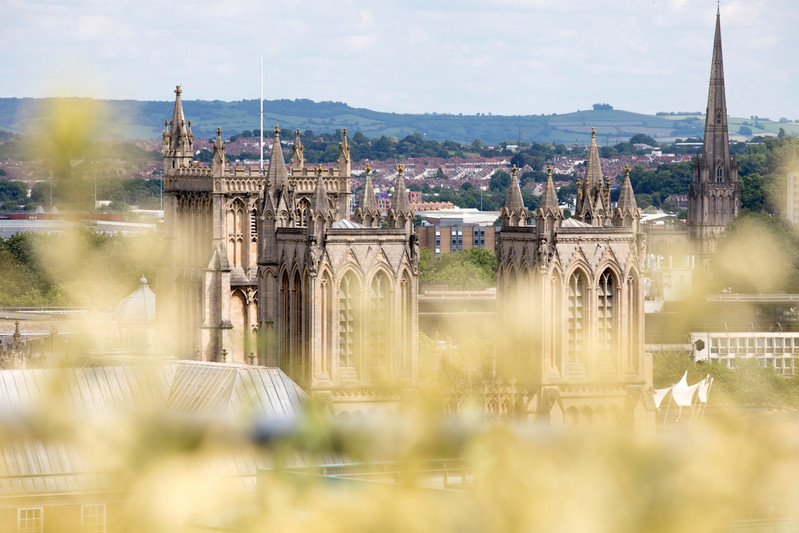This blog post was written by Dr Ola Michalec, a social scientist based at the University of Bristol, researching regulation in the domain of digital innovations for sustainable energy. Ola also serves as a member of the Bristol Advisory Committee for Climate Change and is a member of the Cabot Institute for the Environment.
In the world facing increasingly complex and interdisciplinary challenges, our job descriptions expand to account for new collaborations, duties, and types of knowledge to engage with. Civil servants are now expected to ground their policies in evidence, while scientists are required to translate their findings so that they’re useful to the citizens, industry practitioners or politicians.
Climate action is no different. It comes to life at the curious intersection of activism, political will, market incentives, democratic mandate and, of course, scientific knowledge. As a university researcher, I am on a mission to ensure academic knowledge serves Bristol’s transition to the sustainable city.
An effective collaboration across the worlds of science and policy requires some professional unlearning. Convoluted and jargon-filled academic writing style is not going to cut it if we’re serious about influencing ‘the real world’ (sorry). Similarly, our traditional output formats are simply too long to be accessible for policymakers. I also firmly believe that we ought to advance public debates, rather than solely our respective disciplinary conversations; for that matter we need to invite a broader set of discussants to the table.

After 4 years of researching city-level climate policymaking, my head was filled with ideas and recommendations to the key local decisionmakers. Luckily, upon the completion of my PhD I have been offered a role on the Bristol’s Advisory Committee for Climate Change (BACCC). Over the past two years (well, nearly), we have been scrutinising the development of One City Climate Strategy and advising the local council on their policy development.
What does it involve in practice? – You might be asking. Our work so far has been mostly focusing on synthesising the academic evidence and communicating it in an effective way (with lots of help from a team in PolicyBristol, thank you!). Knowing ‘what works’ to reduce greenhouse gas emissions is one thing, conveying the message to convince politicians and citizens is no less a challenge!
Below, I’d like to tell you about three ways experts at BACCC collaborated with policymakers on local climate action:
- Submission of evidence to the national government inquiry: Covid impact on transport
- Analysis of policy gaps and opportunities: Energy White Paper
- Rapid review of evidence: Low Traffic Neighbourhoods
Submission of evidence to the national government inquiry
Over autumn 2020, Bristol City Council approached us for comments on the national inquiry exploring Covid-19 impacts on transport. At BACCC, we advised the council on the scope of the evidence submission, communication strategy and appropriate ways to present the data. We wanted to convey a message of a city that sees the covid-19 response as a leverage to ‘bounce forward’ to innovative and sustainable transport solutions rather than ‘bounce back’ to the old ways we deemed as normal:
We are hoping that this submission, together with wealth of data on how people move will encourage the national government to devolve significant proportions of transport funding so that city leaders can turn covid emergency measures (e.g. bollards, signage, temporary closures) into high quality urban infrastructure.
Analysis of policy gaps and opportunities
Policy landscape is dynamic; no single person has time to keep up with all the strategic documents, funding announcements and consultation opportunities. It is vital, therefore, that we are able to align the national policy direction with the local climate strategy. In early Spring 2021, we delivered a rapid assessment of gaps & opportunities, following our analysis of the National Government “Energy White Paper” and “10 Point plan”. While there are clear overlaps (e.g. in the funding for electric vehicles, retrofits, heat pumps installation), certain local ambitions cannot be clearly mapped to the national agenda. As such, we risk that Bristol’s plans in the realms of zero-carbon freight consolidation, solar generation or business carbon emissions will not come to fruition.
Rapid review of evidence
Energised by the fierce (yet polarising) debate on Low Traffic Neighbourhoods, we set ourselves to review the literature on the impacts, risks and opportunities on this controversial topic. We reviewed academic literature (from statistical public health analysis to qualitative human geography), news items and policy reports to provide a balanced feedback to the local planners. In particular, we wanted to disentangle empty rhetoric from genuine concerns to cool down the temperature of the conversation.
We provided six key recommendations:
- Reassure that the co-design process is taking place to deliver Low Traffic Neighbourhoods.
- Show compelling evidence on: the benefits to health, safety and lower traffic speed.
- Clarify misconceptions about: potential traffic displacement, lack of accessibility for emergency services, lack of access for deliveries and blue badge holders, loss in customer footfall.
- Acknowledge complexities to do with the potential for short-term disruptions and the risk of gentrification
- Challenge sensationalist media reporting by dispelling unverified claims, exposing exaggerated claims and monitoring the evolving conversation.
- Above all, set out the narrative:
-
- We need to make positive changes: we cannot continue as now for the health and wellbeing of our communities and beyond.
- Some disruption is inevitable, and we will try to mitigate this and work with those affected, though the benefits are real and important.
- What will be delivered will improve the environment for local people – and help to address national and international ambitions.
Access the full review and detailed recommendations.
This post was originally published on the Cabot Institute for the Environment Blog, you can read the original post here.
